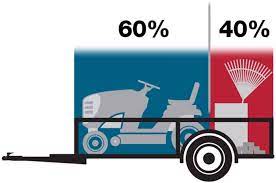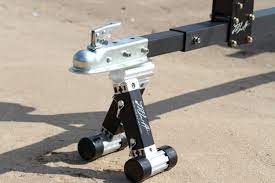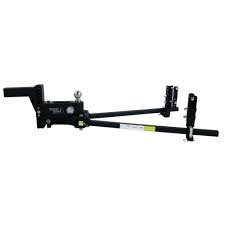How Does a Weight Distribution Hitch Work?
Those with experience in towing likely already understand the importance of a well balanced load in terms of safety and for a generally successful tow. There are many factors that go into a successful tow, one of which is very important and that is good weight distribution.
Why Do You Need a Balanced Load?
If you have ever driven with a loaded trailer and experienced even mild sway from the rear end because of bad load distribution you will know how heart stopping that can be. When you start to lose control of the trailer this can pull the rear end of your tow vehicle around making it harder to steer.
If this is something you have not experienced then count yourself lucky and you should endeavor to avoid this ever happening to you. A well balanced load ensures you have a stable towing experience. Ideally the trailer should follow the movement of your tow vehicle and not cause it to have issues with steering.

This is a safety issue plain and simple so not only is it important to load the trailer correctly but if possible use something to further ensure a well balanced load. A weight distribution hitch for example can be just the thing to help you with difficult loads.
Trailer Weight and Tongue Weight
In understanding the weight distribution hitch you first need to understand the effect of tongue weight when towing a trailer. As a general rule the tongue weight should be 10 – 15% of the total weight of your trailer load.
Just to clarify for those who may not know the tongue is the arm of the trailer that extends out to meet the tow vehicle's hitch. If the tongue weight is not correct this can lead to either too much or not enough downward pressure on the hitch.

This lack of tongue balance can cause serious issues in controlling the vehicle and may even cause damage to the trailer and or the tow vehicle. If you have too much weight near the front of the trailer the tongue weight may be too high and if the weight is at the back of the trailer the reverse issue will exist.
What Is a Weight Distribution Hitch?
So now we come to the weight distribution hitch, what exactly is it? The simple answer is that it is a hitch setup that uses lever action to redistribute weight at the trailer/ tow vehicle connection. In the towing industry the term they use to describe this is Front-Axle Load Restoration or (FALR).
In order to make this work equalizer bars or arms are used to make additional connections to the trailer itself other than the usual coupler and hitch connection.
How Do Weight Distribution Hitches Work?
Ultimately the weight distribution hitch works by distributing the trailer loads more evenly to the tow vehicle. The hitch set up alters the point at which the load connects with the tow vehicle . Generally the weight of towed load is centrally based on the tow vehicle's hitch. The weight distribution hitch spreads the weight across the axles of both the tow vehicle and the trailer.
Choosing the Right Weight Distribution Systems
There are many different weight distribution hitch systems to choose from so it is important to pick the right one for your needs. You first need to take into consideration the weight of your prospective load. These systems are rated in two ways: firstly by gross trailer weight and secondly by tongue weight.
The key is to ensure that the system you get is rated above the trailer and tongue weight you are going to be hauling but not excessively so. As an example if you have a weight distribution hitch rated for 1,000 lbs. but only a load of 500 lbs. to tow then you may issue.
Hauling a load well below the capacity of your weight distribution hitch system can lead to handling problems as can exceeding the rating on your system with a much heavier load. Your aim is to get a system that is as close to the maximum rating as possible without exceeding it.
Once you are happy with your weight rating you will next want to consider what type of spring bars you will need. You have two main options: trunnion or round. The round spring bars are great for giving you more clearance space to hook up your trailer while the trunnions can help boost your system's weight rating.
The final step is to decide if you want any extra features on your weight distribution hitch system. This may include things like sway control. Ideally the system should already help mitigate this but there is always the possibility of sway issues so this might be a handy addition.
How Are Weight Distribution Systems Fitted?
Generally speaking most trailer hitches have a 2-inch receiver into which the weight distribution hitch can be inserted. The spring bars will extend backwards toward the trailer and can be configured upwards or downwards depending on any height difference between trailer coupler and tow vehicle hitch.
The ends of the spring bars are then attached to the trailer frame creating a horizontal A frame. Connected by these springs and chains this system now creates a more stable weight distribution and helps the trailer travel forwards in a straight line matching the direction taken by the tow vehicle.

Each system is slightly different in installation so it is best to consult instructions or have someone help you to set up the first time around. It is important to have the system connected up correctly to make sure it works in the way it is supposed to.
Does a Weight Distribution Hitch Increase Your Towing Capacity?
It is important to make the answer to this question very clear so there is no confusion. These systems are solely for redistributing the trailer load; they can not increase your maximum tow ratings. You will be limited to your tow vehicles set towing abilities.
Conclusion
Weight distribution hitches are specific towing setups that can allow you to get better distribution of heavy loads while towing. Using spring bars and extra connections between tow vehicle and trailer the weight can be spread more evenly ensuring a balanced towing experience.
Link To or Reference This Page
We spend a lot of time collecting, cleaning, merging, and formatting the data that is shown on the site to be as useful to you as possible.
If you found the data or information on this page useful in your research, please use the tool below to properly cite or reference Tow Ratings as the source. We appreciate your support!
-
<a href="http://towratings.net/blog/how-does-a-weight-distribution-hitch-work/">How Does a Weight Distribution Hitch Work?</a>
-
"How Does a Weight Distribution Hitch Work?". Tow Ratings. Accessed on April 26, 2024. http://towratings.net/blog/how-does-a-weight-distribution-hitch-work/.
-
"How Does a Weight Distribution Hitch Work?". Tow Ratings, http://towratings.net/blog/how-does-a-weight-distribution-hitch-work/. Accessed 26 April, 2024
-
How Does a Weight Distribution Hitch Work?. Tow Ratings. Retrieved from http://towratings.net/blog/how-does-a-weight-distribution-hitch-work/.